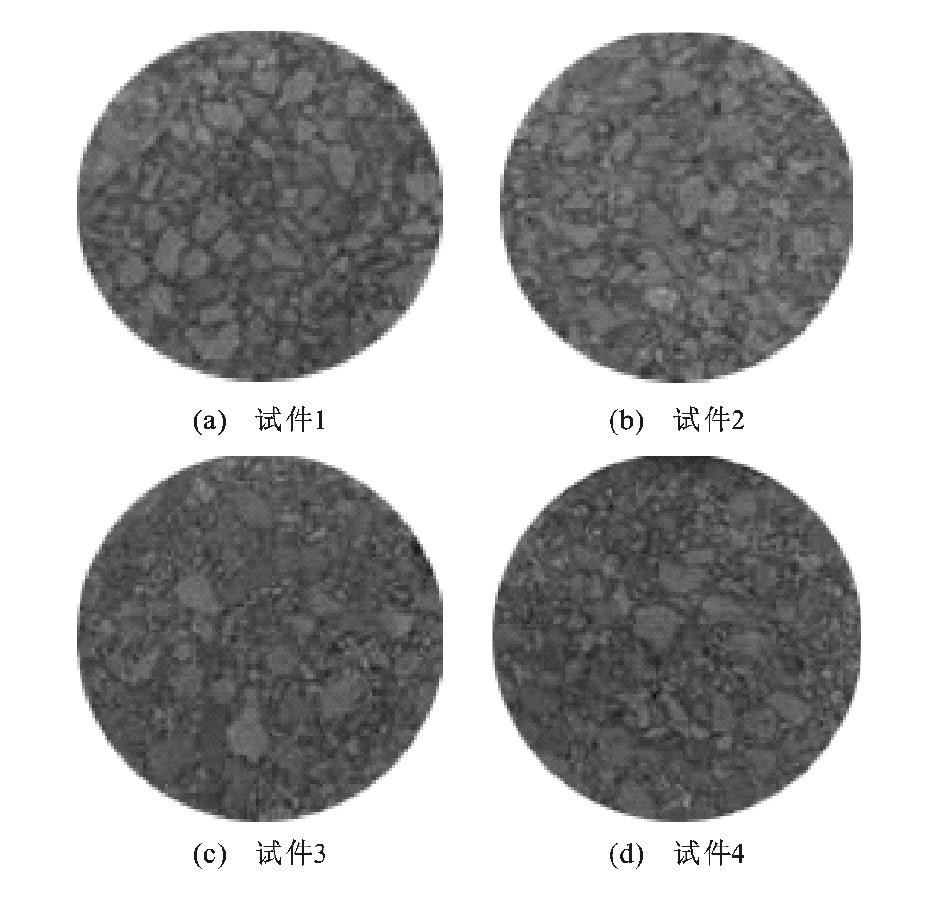Computational method of 3D aggregate angularity based on CT images
-
摘要: 为了提高集料棱角性评价的准确性, 提出了集料三维棱角性计算方法; 基于CT技术和三维重建技术, 对集料的CT图像进行增强和锐化滤镜处理, 以突显沥青混合料中的集料; 对增强后的CT图像进行灰度阈值计算与灰度划分, 采用MIMICS重构了马歇尔试件中集料的三维模型; 提出了集料粗糙度与球形度的评价指标, 依据集料三维模型评价了集料棱角性, 并分析了三维模型重建的影响因素。计算结果表明: 在AC-16马歇尔试件中, 集料、沥青和孔隙的灰度分别为101.32~170.14、4.32~101.32和0~4.32, 因此, 采用图像增强和锐化滤镜处理可以突显CT图像中的集料, 增强集料三维重建的准确性; 采用2pixels×2pixels、3pixels×3pixels锐化滤镜计算球形度标准差为0.000 7, 而采用5pixels×5pixels、6pixels×6pixels、7pixels×7pixels锐化滤镜计算得到的球形度标准差为0.042 3, 因此, 应当采用2pixels×2pixels或3pixels×3pixels锐化滤镜处理CT图像, 以确保球形度计算结果波动小; 采用50、70个·mm-3采样点密度计算粗糙度的标准差为0.001 6, 而采用5、15、25个·mm-3采样点密度计算粗糙度的标准差为0.034 9, 因此, 应当采用50~70个·mm-3采样点密度来保证集料三维模型精确地反映集料的真实状态; 采用5个CT截面图像计算的二维球形度和粗糙度的标准差为0.012 1~0.048 2, 存在较大变异性和偏差, 而采用基于三维集料模型的粗糙度计算方法得到集料15的粗糙度分别为0.991 2、1.032 1、0.974 2、1.075 1、1.043 2, 集料1~5的平均二维粗糙度分别为0.994 1、1.023 9、0.988 3、1.097 5、1.060 8, 两者基本一致。可见, 基于三维集料模型的粗糙度和球形度计算方法充分考虑了集料的棱角性, 计算结果不受CT截面的影响, 计算结果不存在变异和偏差。Abstract: To improve the evaluation accuracy of aggregate angularity, a computational method of3 D aggregate angularity was put forward.Based on CT technology and 3 D reconstruction technology, image intensification and sharpen filter were used to clearly display the aggregates in aggregate CT images, and the gray thresholds of enhanced CT images were calculated and divided.MIMICS was used to reconstruct the 3 D models of aggregates in Marshal specimens.The roughness degree and sphericity degree of aggregate were put forward and taken as evaluation indexes to evaluate aggregate angularity based on the 3 D model.The influence factorsof 3 D model reconstruction were analyzed.Computational result shows the gray values of aggregate, asphalt and pore in AC-16 Marshall specimens are 101.32-170.14, 4.32-101.32, and0-4.32, respectively, so, image intensification and sharpen filter can clearly display aggregates in CT images and improve the 3 Dreconstruction accuracy of aggregate.The computational standard deviation of sphericity degrees is 0.000 7 when the CT images are dealt with by 2 pixels×2 pixels and 3 pixels×3 pixels sharpen filters, and the standard deviation of sphericity degrees is 0.042 3 when the CT images are dealt with by 5 pixels×5 pixels, 6 pixels×6 pixels and 7 pixels×7 pixels sharpen filters.Therefore, 2 pixels×2 pixels or 3 pixels×3 pixels sharpen filter should be adopted to dealt with the CT images in order to ensure the low fluctuation of computed sphericity degree.When sampling point densities are 50 and 70 per cubic millimeter, the standard deviation of roughness degrees is 0.001 6, but when sampling point densities are 5, 15 and 25 per cubic millimeter, the standard deviation of roughness degrees is 0.034 9, so, the density range of sampling points in CT images should be 50-70 per cubic millimeter to ensure that the 3 D models can reflect the real shapes of aggregates precisely.The standard deviations of 2 D sphericity degrees and roughness degrees based on 5 CT cross sections are 0.012 1-0.048 2, which reflects the larger variability and deviation.However, the roughness degrees of aggregates 1-5 calculated by the method based on the 3 D models are 0.991 2, 1.032 1, 0.974 2, 1.075 1, 1.043 2, respectively, and the corresponding average 2 Droughness degrees of aggregates 1-5 are 0.994 1, 1.023 9, 0.988 3, 1.097 5 and 1.060 8, respectively, which shows the 3 Dand 2 Droughness degrees are basically same.Obviously, the computational method based on the 3 D model used to calculate the roughness degree and sphericity degree fully considers the 3 D angularity of aggregate, the calculation result is not affected by the selected CT cross sections, and there are no calculation variability and deviation.
-
Key words:
- pavement material /
- aggregate angularity /
- CT technology /
- 3Dreconstruction /
- sharpen filter /
- gray threshold
-
表 1 AC-16沥青混凝土配合比
Table 1. AC-16 asphalt concrete graduations

表 2 CT参数
Table 2. CT parameters

表 3 不同材料的灰度阈值
Table 3. Gray thresholds of different materials

表 4 计算结果对比
Table 4. Comparison of computation results

-
[1] KUTAY M E, OZTURK H I, ABBAS A R, et al. Comparison of 2Dand 3Dimage-based aggregate morphological indices[J]. International Journal of Pavement Engineering, 2011, 12 (4): 421-431. doi: 10.1080/10298436.2011.575137 [2] TUTUMLUER E, PAN Tong-yan. Aggregate morphology affecting strength and permanent deformation behavior of unbound aggregate materials[J]. Journal of Materials in Civil Engineering, 2008, 20 (9): 617-627. doi: 10.1061/(ASCE)0899-1561(2008)20:9(617) [3] HU Li-qun, YUN Di, LIU Zhuang-zhuang, et al. Effect of three-dimensional macrotexture characteristics on dynamic frictional coefficient of asphalt pavement surface[J]. Construction and Building Materials, 2016, 126: 720-729. doi: 10.1016/j.conbuildmat.2016.09.088 [4] ZHU Feng, LIAO Jia-xin, XUE Sheng-guo, et al. Evaluation of aggregate microstructures following natural regeneration in bauxite residue as characterized by synchrotron-based X-ray micro-computed tomography[J]. Science of the Total Environment, 2016, 573: 155-163. doi: 10.1016/j.scitotenv.2016.08.108 [5] 闵永智, 殷超, 党建武, 等. 基于图像色相值突变特征的钢轨区域快速识别方法[J]. 交通运输工程学报, 2016, 16 (1): 46-54. doi: 10.3969/j.issn.1671-1637.2016.01.006MIN Yong-zhi, YIN Chao, DANG Jian-wu, et al. Fast recognition method of rail region based on hue value mutation feature of image[J]. Journal of Traffic and Transportation Engineering, 2016, 16 (1): 46-54. (in Chinese). doi: 10.3969/j.issn.1671-1637.2016.01.006 [6] TONG Zheng, GAO J, ZHANG Hai-tao. Innovation for evaluating aggregate angularity based upon 3Dconvolutional neural network[J]. Construction and Building Materials, 2017, 155: 919-929. doi: 10.1016/j.conbuildmat.2017.08.129 [7] RAJAN B, SINGH D. Understanding influence of crushers on shape characteristics of fine aggregates based on digital image and conventional techniques[J]. Construction and Building Materials, 2017, 150: 833-843. doi: 10.1016/j.conbuildmat.2017.06.058 [8] RAVANSHAD A, ROQUE R, TEBALDI G, et al. Evaluation of two-dimensional gray-scale images for microtexture analysis of aggregate surface[J]. Journal of Materials in Civil Engineering, 2016, 28 (8): 1-9. [9] HAN Jian-den, LIU Wei-qing, WANG Shu-guang et al. Effects of crack and ITZ and aggregate on carbonation penetration based on 3D micro X-ray CT microstructure evolution[J]. Construction and Building Materials, 2016, 128: 256-271. doi: 10.1016/j.conbuildmat.2016.10.062 [10] CHUNG Sang-yeop, HAN Tong-Seok, YUN Tae-sup, et al. Evaluation of the anisotropy of the void distribution and the stiffness of lightweight aggregates using CT imaging[J]. Construction and Building Materials, 2013, 48: 998-1008. doi: 10.1016/j.conbuildmat.2013.07.082 [11] ZHAO Guo-tang, SHE Wei, YANG Guo-tao, et al. Mechanism of cement on the performance of cement stabilized aggregate for high speed railway roadbed[J]. Construction and Building Materials, 2017, 144, 347-356. doi: 10.1016/j.conbuildmat.2017.03.194 [12] GARBOUT A, MUNKHOLM L J, HANSEN S B. Temporal dynamics for soil aggregates determined using X-ray CT scanning[J]. Geoderma, 2013, 204-205: 15-22. doi: 10.1016/j.geoderma.2013.04.004 [13] CHEN Si-yu, YANG X, YOU Zhan-ping, et al. Innovation of aggregate angularity characterization using gradient approach based upon the traditional and modified Sobel operation[J]. Construction and Building Materials, 2016, 120: 442-449. doi: 10.1016/j.conbuildmat.2016.05.120 [14] TAFESSE S, ROBISON FERNLUND J M, SUN Wen-juan, et al. Evaluation of image analysis methods used for quantification of particle angularity[J]. Sedimentology, 2013, 60 (4): 1100-1110. doi: 10.1111/j.1365-3091.2012.01367.x [15] 汪海年, 卜胤, 周洋, 等. 基于X-Ray CT技术的沥青混合料扫描影响因素及其优化研究[J]. 公路交通科技, 2014, 31 (11): 9-15. doi: 10.3969/j.issn.1002-0268.2014.11.002WANG Hai-nian, BU Yin, ZHOU Yang, et al. Research on influencing factors and its optimization of scanning asphalt mixture based on X-ray CT technology[J]. Journal of Highway and Transportation Research and Development, 2014, 31 (11): 9-15. (in Chinese). doi: 10.3969/j.issn.1002-0268.2014.11.002 [16] 唐伯明, 郭鹏, 肖巧林, 等. 沥青混凝土再生集料的棱角性分析[J]. 中国公路学报, 2015, 28 (1), 24-29. doi: 10.3969/j.issn.1001-7372.2015.01.004TANG Bo-ming, GUO Peng, XIAO Qiao-lin, et al. Analysis of angularity of asphalt concrete recycled aggregate[J]. China Journal of Highway and Transport, 2015, 28 (1): 24-29. (in Chinese). doi: 10.3969/j.issn.1001-7372.2015.01.004 [17] MASAD E, OLCOTT D, WHITE T, et al. Correlation of fine aggregate imaging shape indices with asphalt mixture performance[J]. Transportation Research Record, 2001 (1757): 148-156. [18] JU Yang, WANG Li, XIE He-ping, et al. Visualization of the three-dimensional structure and stress field of aggregated concrete materials through 3D printing and frozen-stress techniques[J]. Construction and Building Materials, 2017, 143: 121-137. doi: 10.1016/j.conbuildmat.2017.03.102 [19] 郭乃胜, 尤占平, 谭忆秋, 等. 考虑均匀性的沥青混合料最佳沥青用量确定方法[J]. 交通运输工程学报, 2017, 17 (1): 1-10. doi: 10.3969/j.issn.1671-1637.2017.01.001GUO Nai-sheng, YOU Zhan-ping, TAN Yi-qiu, et al. Determination method of optimum asphalt content in asphalt mixture under considering homogeneity[J]. Journal of Traffic and Transportation Engineering, 2017, 17 (1): 1-10. (in Chinese). doi: 10.3969/j.issn.1671-1637.2017.01.001 [20] 马天寿, 陈平. 基于CT扫描技术研究页岩水化细观损伤特性[J]. 石油勘探与开发, 2014, 41 (2): 227-233. https://www.cnki.com.cn/Article/CJFDTOTAL-SKYK201402015.htmMA Tian-shou, CHEN Ping. Study of meso-damage characteristics of shale hydration based on CT scanning technology[J]. Petroleum Exploration and Development, 2014, 41 (2): 227-233. (in Chinese). https://www.cnki.com.cn/Article/CJFDTOTAL-SKYK201402015.htm [21] 江洎洧, 项伟, 张雪杨. 基于CT扫描和仿真试验研究黄土坡滑坡原状滑带土力学参数[J]. 岩石力学与工程学报, 2011, 30 (5): 1025-1033. https://www.cnki.com.cn/Article/CJFDTOTAL-YSLX201105021.htmJIANG Ji-wei, XIANG Wei, ZHANG Xue-yang. Research on mechanical parameters of intact sliding zone soils of Huangtupo landside based on CT scanning and simulation tests[J]. Chinese Journal of Rock Mechanics and Engineering, 2011, 30 (5): 1025-1033. (in Chinese). https://www.cnki.com.cn/Article/CJFDTOTAL-YSLX201105021.htm [22] 金灿, 王鑫磊, 刘凯, 等. 基于CT图像的沥青混合料细观建模及数值仿真研究进展[J]. 公路, 2016 (9): 232-239. https://www.cnki.com.cn/Article/CJFDTOTAL-GLGL201609056.htmJIN Can, WANG Xin-lei, LIU Kai, et al. Mesoscopic modeling of asphalt mixture and numerical simulation research progress based on CT images[J]. Highway, 2016 (9): 232-239. (in Chinese). https://www.cnki.com.cn/Article/CJFDTOTAL-GLGL201609056.htm [23] 冯杰, 于纪玉. 利用CT扫描技术确定土壤大孔隙分形维数[J]. 灌溉排水学报, 2005, 24 (4): 26-28, 40. https://www.cnki.com.cn/Article/CJFDTOTAL-GGPS200504006.htmFENG Jie, YU Ji-yu. Determination fractal dimension of soil macropore using computed tomography[J]. Journal of Irrigation and Drainage, 2005, 24 (4): 26-28, 40. (in Chinese). https://www.cnki.com.cn/Article/CJFDTOTAL-GGPS200504006.htm [24] GAO Jie, WANG Zhen-jun, ZHANG Ting, et al. Dispersion of carbon fibers in cement-based composites with different mixing methods[J]. Construction and Building Materials, 2017, 134: 220-227. doi: 10.1016/j.conbuildmat.2016.12.047 [25] 汪海年, 郝培文, 肖庆一, 等. 粗集料棱角性的图像评价方法[J]. 东南大学学报: 自然科学版, 2008, 38 (4): 637-641. doi: 10.3321/j.issn:1001-0505.2008.04.018WANG Hai-nian, HAO Pei-wen, XIAO Qing-yi, et al. Digital image evaluation method for angularity of coarse aggregates[J]. Journal of Southeast University: Natural Science Edition, 2008, 38 (4): 637-641. (in Chinese). doi: 10.3321/j.issn:1001-0505.2008.04.018 [26] 李嘉, 林辉. 基于数字图像处理的粗集料棱角性量化研究[J]. 公路交通科技, 2008, 25 (7): 27-31. https://www.cnki.com.cn/Article/CJFDTOTAL-GLJK200807005.htmLI Jia, LIN Hui. Quantification research of coarse aggregate angularity based on digital image processing[J]. Journal of Highway and Transportation Research and Development, 2008, 25 (7): 27-31. (in Chinese). https://www.cnki.com.cn/Article/CJFDTOTAL-GLJK200807005.htm -





 下载:
下载:


















